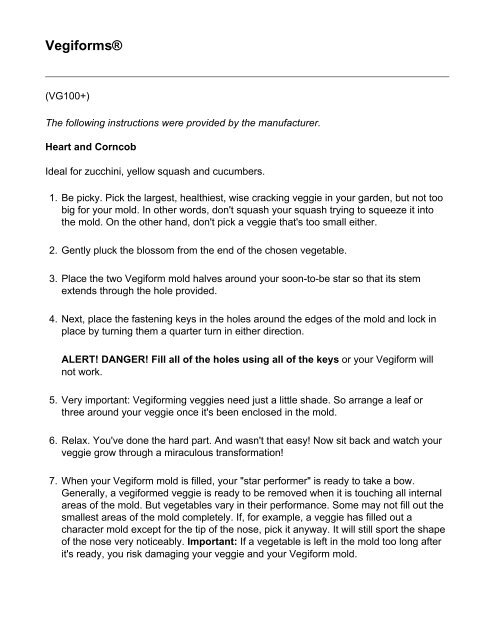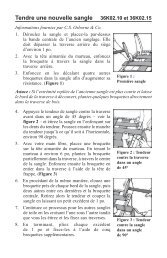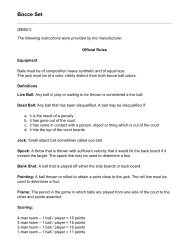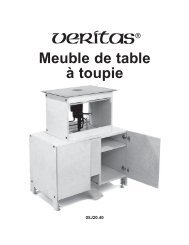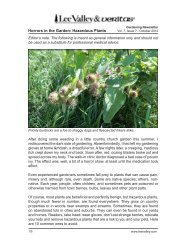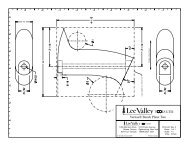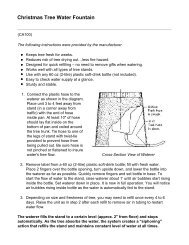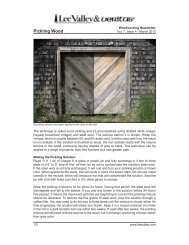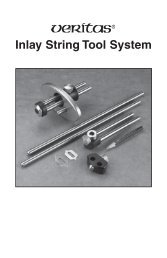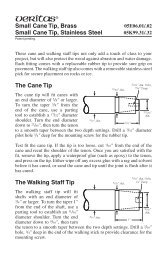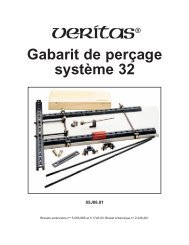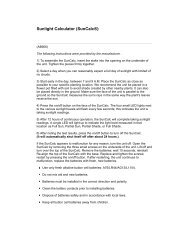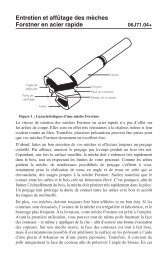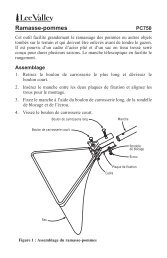You also want an ePaper? Increase the reach of your titles
YUMPU automatically turns print PDFs into web optimized ePapers that Google loves.
<strong>Vegiforms®</strong><br />
(VG100+)<br />
The following instructions were provided by the manufacturer.<br />
Heart and Corncob<br />
Ideal for zucchini, yellow squash and cucumbers.<br />
1. Be picky. Pick the largest, healthiest, wise cracking veggie in your garden, but not too<br />
big for your mold. In other words, don't squash your squash trying to squeeze it into<br />
the mold. On the other hand, don't pick a veggie that's too small either.<br />
2. Gently pluck the blossom from the end of the chosen vegetable.<br />
3. Place the two Vegiform mold halves around your soon-to-be star so that its stem<br />
extends through the hole provided.<br />
4. Next, place the fastening keys in the holes around the edges of the mold and lock in<br />
place by turning them a quarter turn in either direction.<br />
ALERT! DANGER! Fill all of the holes using all of the keys or your Vegiform will<br />
not work.<br />
5. Very important: Vegiforming veggies need just a little shade. So arrange a leaf or<br />
three around your veggie once it's been enclosed in the mold.<br />
6. Relax. You've done the hard part. And wasn't that easy! Now sit back and watch your<br />
veggie grow through a miraculous transformation!<br />
7. When your Vegiform mold is filled, your "star performer" is ready to take a bow.<br />
Generally, a vegiformed veggie is ready to be removed when it is touching all internal<br />
areas of the mold. But vegetables vary in their performance. Some may not fill out the<br />
smallest areas of the mold completely. If, for example, a veggie has filled out a<br />
character mold except for the tip of the nose, pick it anyway. It will still sport the shape<br />
of the nose very noticeably. Important: If a vegetable is left in the mold too long after<br />
it's ready, you risk damaging your veggie and your Vegiform mold.
8. Now the fun part! Cut the vegetable off its stem while it's still inside the mold. Remove<br />
all keys. Grasp the stem end of the mold in both hands and pull it apart. If the mold<br />
does not easily come apart, simply insert a screwdriver between the halves and<br />
gently pry them apart. If after pulling the mold apart your veggie is stuck in either half,<br />
hold the side of the mold down while gently tugging on the vegetable's stem until it's<br />
free.<br />
9. Enjoy. Whether you slice and serve it, display it, or bestow it, your unique vegetable<br />
creation will be a garden of delights for everyone who sees (and tastes) it. And it's just<br />
the beginning. Because you can use your Vegiform mold again and again.<br />
Garden Elf<br />
A word about elves. Like the legendary elves of old, the Vegiform Garden Elf is very<br />
special. It's the most versatile Vegiform — ideal for eggplant, pumpkin, globe squash,<br />
melons, gourds and other fruits and vegetables. It's also designed to grow formed<br />
veggies much larger than the mold itself. Magic you say? Perhaps. Read on to find out<br />
how you can perform this trick.<br />
1. Follow instructions 1-7 for the Heart and Corncob.<br />
2. When your pumpkin, eggplant, melon, etc. has filled the Garden Elf mold, you now<br />
have a delightful choice: you can either clip the veggie (as in step #8 above) and<br />
enjoy, or you can simply remove the mold and leave your prize Garden Elf on the<br />
vine. It will continue to grow in the form of the mold. Just imagine the sight of full-size<br />
watermelons and pumpkins with delightful Garden Elf faces. Whether you grow them<br />
large or small, you'll really enjoy gardening with this Vegiform favorite.<br />
Pickle Pair<br />
Ideal for cucumber, zucchini, yellow squash and other fruits and vegetables.<br />
1. Fasten the mold halves securely with the fastening straps before placing on the plant.<br />
2. Pick out a vigorously growing plant that "fits the mold". Not too big and not too small.<br />
3. Place the mold over the vegetable.<br />
4. Sit back and let nature take its course. But don't forget to water, shade, etc.<br />
5. When the veggie has filled the mold, simply remove the straps and separate the<br />
halves.
Note: The fastening straps provided are for one use only. When you run out, use stout<br />
twine or any strap that securely holds the mold halves together.<br />
If at First You Don't Succeed...<br />
In most cases, if you're having trouble molding a veggie, you should remove the old one<br />
and try another vegetable. If you're still unsuccessful, take this simple test:<br />
Q. Are your vegetables discoloring in the mold?<br />
A. If so, remove the mold and place it on another vegetable.<br />
Q. Is the veggie growing smaller inside the mold?<br />
A. If yes, this veggie does not want to be a "star". Pick another.<br />
Vegiform Maintenance<br />
Just keep your Vegiform molds clean with soap and water. Absolutely no abrasive<br />
cleaners.<br />
If You Lose a Key<br />
The keys aren't essential. Ordinary nuts and bolts will do just fine. Just be sure to place a<br />
washer against each side of the mold.


